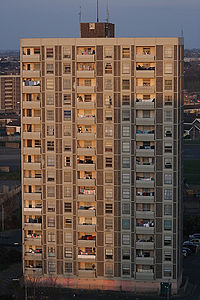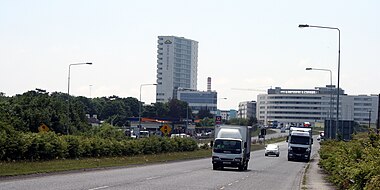Ballymun
Ballymun (Irish:Baile Munna), nicknamed "The Mun", is an area on Dublin's Northside close to Dublin Airport, Ireland. It is infamous for the Ballymun flats, which became a symbol of poverty, alienation from the state and social problems in Ireland since the 1970s. Today it is undergoing a multi-billion euro renewal, with the renovated village centre, surrounded by estates of houses and apartments, with several sub-districts such as Sillogue and Poppintree.
Ballymun had a population of 22,109 at the 2006 Census.
Amenities
Today Ballymun has a wide range of amenities, from green spaces and the public Sillogue Golf Course to a Tesco-owned shopping centre, a range of other shops and pubs and a hotel, to a public sector office development, with many branches of the city government (including a Motor Tax and Driver Licence office) and the Health Service and a very modern public leisure centre. There is a church in the old village centre, and a number of schools, including an Educate Together primary school.
History and Nature
Historically, Ballymun was a larger area than it is now, but quite rural, with a small village centre. Due to what were seen to be undesirable associations, the area has shrunk since the completion of the flats. For instance in the early days of Dublin City University, then called NIHE, Dublin, this institution was referred to as being in Ballymun (part of the "Ballymun Project") whilst today it is referred to and has a postal address in Whitehall even though it has not changed location; indeed much of the present day Ballymun town centre was comprised of the northern site of Albert Agricultural College, the forerunner of the present-day university, Dublin City University. Streets have also been renamed. For example, Ballymun Avenue was renamed Glasnevin Avenue after a local plebiscite in the 1970s.
Despite its reputation, Ballymun is a thriving community with a high standard of living.[citation needed] New housing estates are currently being built which will provide a mixture of private and social housing.
Ballymun Flats

The flats have, to all intents and purposes, defined Ballymun with areas hitherto in Ballymun lobbying successfully for political support to redesignate their homes as part of neighbouring areas. Among the opprobrium heaped on Ballymun, the deployment of the flats has been described by the environmental journalist, Frank McDonald, in his book The Construction of Dublin, as the Irish state's 'worst planning disaster'. There were three types of flats: seven fifteen storey towers; seventeen eight storey blocks; five four storey blocks. The flats were built in the 1960s under the authority of Neil Blaney, the then Fianna Fáil Minister for Local Government. They incorporated the best social housing practice of the time. The first tenants moved in between August 1966 and December 1966. By February 1969, when the National Building Agency's contract for Ballymun ceased and control of Ballymun was handed back to Dublin City Council, there was a total of 3,021 dwellings in the new Ballymun, all of which was social housing under the control of the Irish state through Dublin City Council.
The tenants primarily came from the most deprived areas of inner city Dublin, places where the depth of poverty could not be conceived of in modern Ireland. They arrived in Ballymun to some of the finest social housing in Europe, having central heating and other rarities of the day in their homes.
However, there was a profound lack of amenities throughout the area - initially the only shop was a van, for example - and, combined with a lack of trees, and estates built in cul de sacs, ghettoisation developed. By the recession of the 1980s, Ballymun was infested with social problems, most especially alcohol and other drug abuse. Although the public image of Ballymun has changed somewhat since the beginning of the Ballymun regeneration project in 1997, the social problems in Ballymun ensure it remains a remarkably different world to even neighbouring Glasnevin.
Regeneration of Ballymun
The creation of Ballymun Regeneration Limited as a limited company of Dublin City Council initiated the beginning of the demolition of the Ballymun flats and the emergence of a new town of Ballymun. To date (2008), four of the seven towers; Pearse, Ceannt, james connolyy McDonaghand sean macdermott towers as well as two eight storey blocks, and four four storey blocks have been demolished, with the residents usually rehoused in new state of the art housing in Ballymun. The new housing is a mixture of public, private, voluntary and co-operative housing. The new town of Ballymun is due to be completed by 2013.
The regeneration project, despite well-publicised questions about accountability and democratic participation, has also delivered many other amenities, including reworked park areas, a major City Council office facility, Health Service facilities, a public leisure centre, a new hotel and renewed shopping areas.
As part of the New Ballymun, a major tree-planting project called Amaptocare has been run, with people sponsoring trees and providing inscription texts which are engraved on plaques near the trees.
Sport
There are a number of local sports groups, including football club Ballymun Kickhams GAA and Ballymun United Football Club.

Points of Note
Ballymun has featured as a generic working class Dublin suburb in films such as Into the West, The Commitments and The Snapper.
The lines "I see seven towers/But I only see one way out" in the U2 song 'Running to Stand Still' are a reference to the towers in Ballymun. In addition, the lyrics of the U2 song 'Bad' focus on drug use in the Ballymun flats. When Bono, the lead singer of U2, was born in the Rotunda Hospital in 1960 his family lived in No 10 Cedarwood Road, Glasnevin. The landscape of the nascent flats which lay less than a kilometre from his home made a marked impression on the young singer.
"The Mun" by Lynn Connolly chronicles Ballymun from the 1960s to present day; unlike most media portrayals of Ballymun, it focuses on the more positive elements of the community.
External links
- New Ballymun dot com
- Ballymun Regeneration Ltd, with much about all aspects of the regeneration
- Photos of the demolition of one of the flats
- News about Ballymun and Ballymun Partnership
- Ballymun United Football Club
- Ballymun Kickhams GAA Club
